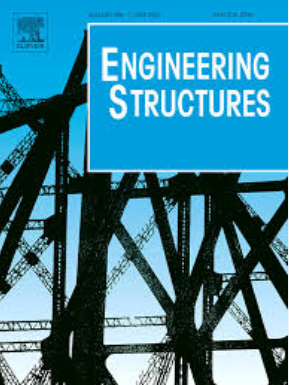一种用于混凝土预制结构改造的新型双向摩擦阻尼器:试验与数值评估
IF 5.6
1区 工程技术
Q1 ENGINEERING, CIVIL
引用次数: 0
摘要
自20世纪60年代 以来,预制钢筋混凝土结构通常用于工业和商业建筑,由于不合标准的旧建筑规范,其主要结构元件之间以及结构和非结构部件之间的连接往往很差。如此高的易损性,再加上相当大的暴露值,导致了不成比例的地震风险。为了解决这一问题,介绍了一种新型的混凝土预制结构双向旋转摩擦阻尼器(BRFD)。这种易于安装、低成本且可重复使用的阻尼器同时具有梁柱节点和双向耗散能力,可提高抗震性能并防止脆性破坏。BRFD的双向能力需要一种独特的测试方法,通过实验和数值分析进行验证。一个特设设置与两个正交致动器被用来测试阻尼器的行为,测量力,位移和温度在不同的水平。实验结果通过在Opensees环境中开发一个精细的数值模型来验证,该模型再现了所有BRFD元素的行为。结果表明,BRFD具有良好的双向特性,既具有迟滞稳定性,又具有良好的阻尼能力。本文章由计算机程序翻译,如有差异,请以英文原文为准。
A novel bidirectional friction damper for retrofitting of RC precast structures: Experimental and numerical assessment
Precast RC structures, commonly used since the '60 s for industrial and commercial buildings, often feature poor connections among the main structural elements and between structural and non-structural components due to sub-standard old building codes. Such a high vulnerability, in combination with the considerable exposed value, leads to a disproportionate seismic risk. To address this, a novel Bidirectional Rotation Friction Damper (BRFD) for RC precast structures is introduced. This easy-to-install, low-cost, and reusable damper simultaneously behaves as a beam-to-column joint and a damper with bidirectional dissipative capacity, improving seismic performance and preventing brittle failures. The BRFD's bidirectional capacity requires a unique testing methodology, validated through experimental and numerical analysis. An ad hoc setup with two orthogonal actuators was used to test the damper's behavior, measuring forces, displacements, and temperatures at varying levels. The experimental results are validated with FEM analysis in the Opensees environment by developing a refined numerical model that reproduces the behaviour of all the BRFD elements. Results show the promising bidirectional behaviour of the BRFD, both in terms of hysteresis steadiness and good damping capacity.
求助全文
通过发布文献求助,成功后即可免费获取论文全文。
去求助
来源期刊

Engineering Structures
工程技术-工程:土木
CiteScore
10.20
自引率
14.50%
发文量
1385
审稿时长
67 days
期刊介绍:
Engineering Structures provides a forum for a broad blend of scientific and technical papers to reflect the evolving needs of the structural engineering and structural mechanics communities. Particularly welcome are contributions dealing with applications of structural engineering and mechanics principles in all areas of technology. The journal aspires to a broad and integrated coverage of the effects of dynamic loadings and of the modelling techniques whereby the structural response to these loadings may be computed.
The scope of Engineering Structures encompasses, but is not restricted to, the following areas: infrastructure engineering; earthquake engineering; structure-fluid-soil interaction; wind engineering; fire engineering; blast engineering; structural reliability/stability; life assessment/integrity; structural health monitoring; multi-hazard engineering; structural dynamics; optimization; expert systems; experimental modelling; performance-based design; multiscale analysis; value engineering.
Topics of interest include: tall buildings; innovative structures; environmentally responsive structures; bridges; stadiums; commercial and public buildings; transmission towers; television and telecommunication masts; foldable structures; cooling towers; plates and shells; suspension structures; protective structures; smart structures; nuclear reactors; dams; pressure vessels; pipelines; tunnels.
Engineering Structures also publishes review articles, short communications and discussions, book reviews, and a diary on international events related to any aspect of structural engineering.
 求助内容:
求助内容: 应助结果提醒方式:
应助结果提醒方式:


